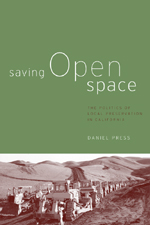|
 News News
 Subscribe to Our Newsletter Subscribe to Our Newsletter
 Sign up for Email Updates
Sign up for Email Updates
 CGF In the News
CGF In the News
 Press Inquiries Press Inquiries
 Past Articles Past Articles
 Calendar Calendar
|
|
|
Book review:
"Saving
Open Space" offers broad perspective on what works
by Pete Holloran
 Local governments and land trusts have protected more than 570,000 acres of
California open space since the 1920s. Given the relentless development forces arrayed against them, why have some communities been successful in protecting open space while others have
struggled? Why, for example, did Alameda and Contra Costa voters approve an increase in their property taxes at the height of the Great Depression to purchase expensive
ridge-top lands? These are not idle questions - especially when we may now be teetering on the edge of an extended recession. Local governments and land trusts have protected more than 570,000 acres of
California open space since the 1920s. Given the relentless development forces arrayed against them, why have some communities been successful in protecting open space while others have
struggled? Why, for example, did Alameda and Contra Costa voters approve an increase in their property taxes at the height of the Great Depression to purchase expensive
ridge-top lands? These are not idle questions - especially when we may now be teetering on the edge of an extended recession.
In
Saving Open Space, a book published late last year by University of California Press, Daniel Press addresses such
questions in a revealing work that helps situate local open space battles in a statewide context. We learn, for example that Santa Clara County is among the most effective in the state at preserving
local open space - and that organizations like Committee for Green Foothills have played a key role in that effort. These findings, while hardly surprising to
Green Footnotes readers, are just the beginning. What really interests Press is the
matter of causation. "What are the conditions," he asks, "for creating innovative, effective land preservation institutions at the
local level?" Think of California as a great natural experiment in which counties, operating under similar constraints imposed by the state and federal government, achieve quite different levels of
open space protection. To explain this variability in outcome, Press proposes what he calls the policy capacity model. He defines a community's policy capacity as "its ability and willingness
to respond to public problems and opportunities." Some counties develop such capacities, while others are less successful in doing so. Three factors contribute to a community's environmental policy
capacity: political resources (e.g. local revenues and administrative expertise), civic resources (voluntarism and political engagement), and external constraints (landscape features and development
pressure). Press tests this policy capacity model using a wide range of evidence. He interviewed dozens of local elected officials and activists, examined county voting records for 70 statewide
environmental measures, and even conducted telephone surveys with 4,100 California residents. Some of his findings aren't too surprising: that high levels of open
space protection are correlated with highly visible hillsides threatened with development (Marin, the East Bay, the Peninsula), rivers running through urban areas (Napa River, for example), and
community wealth (Los Angeles). (Believe it or not, Los Angeles has protected more land at the local level than any other county. Of course, much of it is in the Owens Valley, in another county.)
My favorite part of the book focuses on the role of civic engagement and voluntarism - what Press calls civic environmentalism - in enabling communities to preserve open space. Non-profit organizations like
Committee for Green Foothills and
Peninsula Open Space Trust play a central role in developing and channeling local environmental policy capacity.
If you want an inspiring story of local communities acting to protect the public good against overwhelming odds, check out Saving Open Space. Daniel Press reminds us of just how far
we've come, how we got here, and how far we have to go.
Pete Holloran is a civic environmentalist working on his Ph.D. in environmental studies at UC Santa Cruz. Daniel
Press, a professor in that department, just happens to be his advisor.
Published July 2003 in
Green Footnotes.
Page last updated July 7, 2003 |
|
![]()
![]()




